The Dell Venue 11 Pro 7000 Review
by Brett Howse on April 16, 2015 8:00 AM EST- Posted in
- Tablets
- Dell
- Windows 8.1
- Core M
Tablet Performance
So far we have compared the Venue 11 Pro with its Windows PC based brethren. And that is a fair comparison to make, since the Venue 11 Pro is offered with accessories to transform it into exactly that. But to complete the picture we should take a look at how it performs as a pure tablet.
We do not have all of the same benchmarks available on Windows as we do on iOS and Android, but we will make what comparisons we can to get a general feel for how this tablet compares against competing devices.
Web Performance
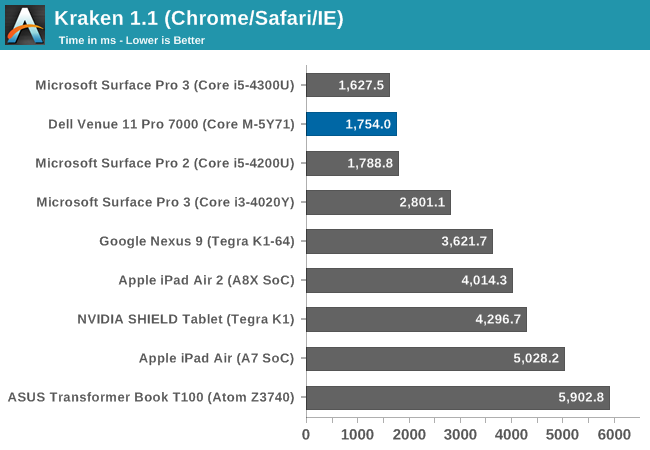


Core M offers a lot more performance than any of the ARM based tablets when it comes to CPU bound tasks. It is easily double the performance of the best ARM or Atom based devices. It is a pretty great achievement when you look at how far back Intel was in the mobile game a few years ago. Atom got them to somewhat competitive performance and TDP, but Core M has pushed them well past. Of course that is ignoring the huge price differential, with the Core M CPU having a tray price of more than many Android tablets, as well as the larger circuit board that Core M requires. Intel still has Atom, and for good reason. They can and do price Core M at a premium, but have Atom to provide the less expensive option.
3DMark Unlimited
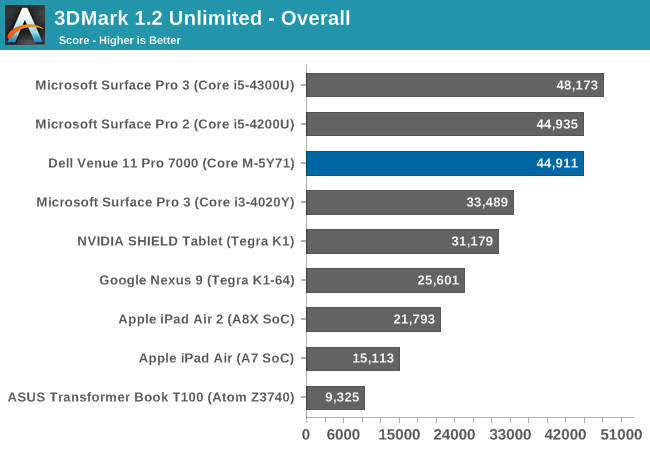
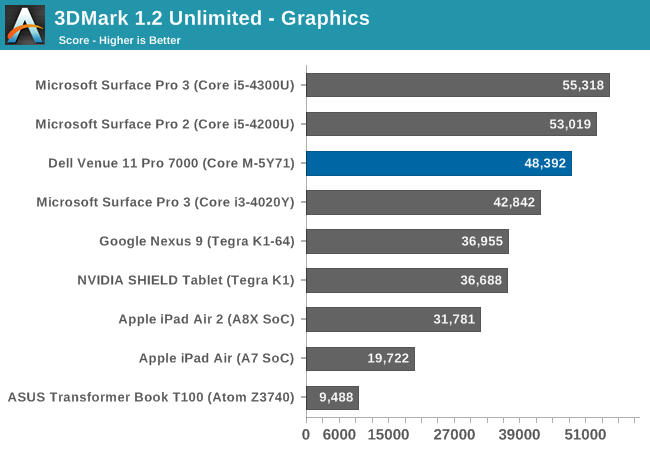

Ice Storm Unlimited is rendered off-screen, so that it can be used to compare across devices and platforms. As we have seen in the PC comparison, the Venue 11 Pro can perform quite well if given such a short benchmark. This does show to capabilities of the GPU inside, but unfortunately it is more limited in performance when doing longer workloads.
GFXBench
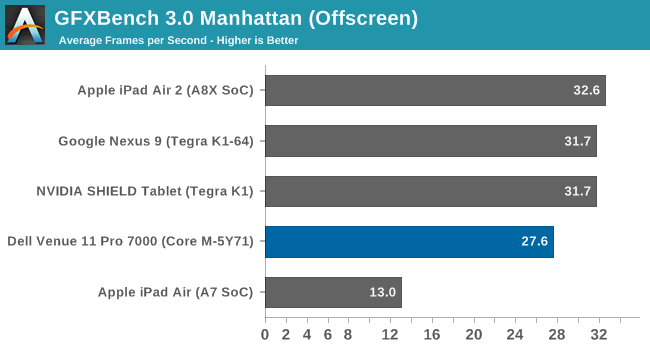
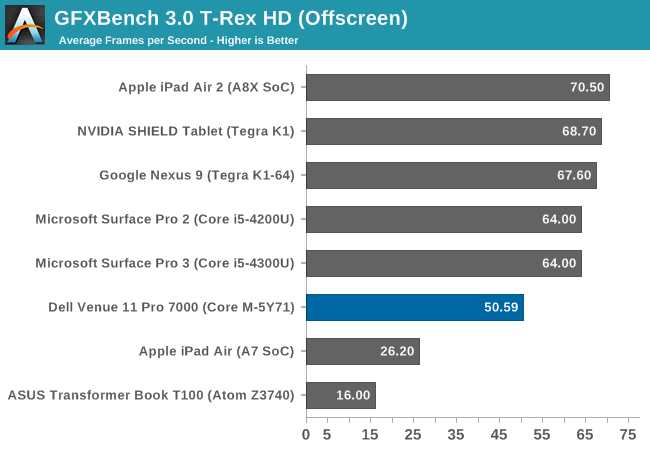
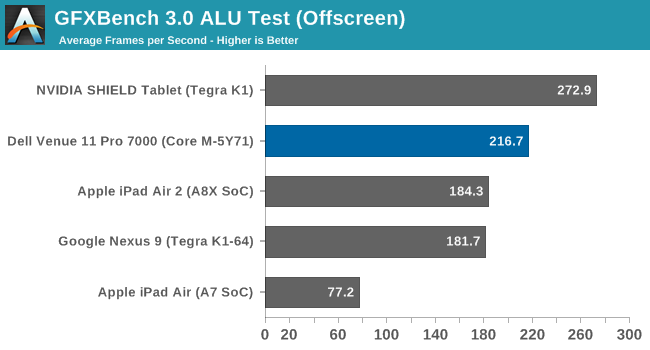
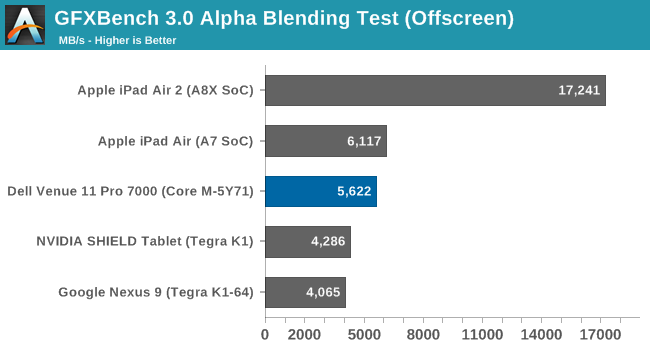
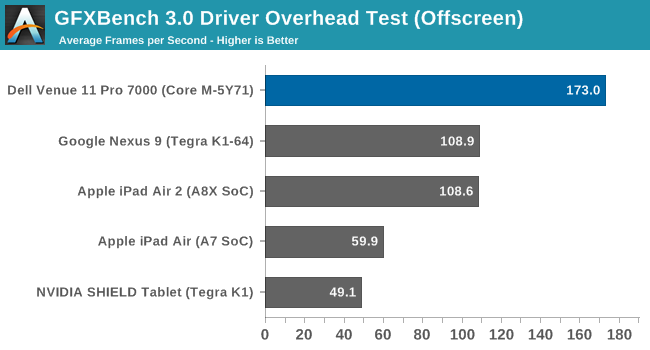
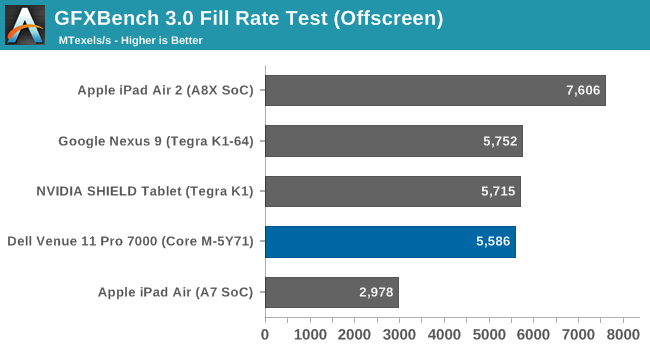
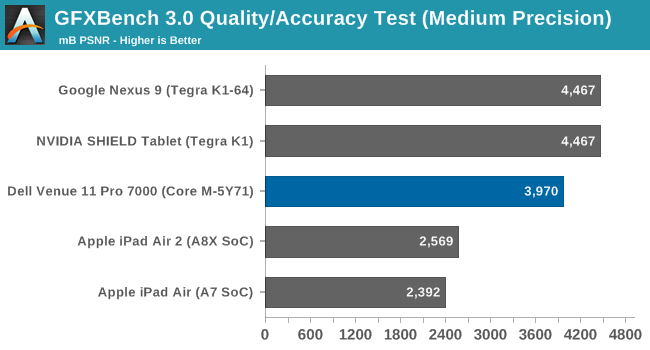

On the CPU side, Core M dominates the ARM competition, but on the GPU front it is not the same story. As we saw in 3DMark, the GPU can perform very well, but on a test like this where sustained performance is required, the performance does drop off quite a bit. The GPU is not terrible, but it cannot compete with the top GPUs available in a tablet today. Perhaps that will change with Skylake. At the moment, it is only ok.
NAND Performance
The Venue 11 Pro has an older model of SSD, but it is still a SSD, where as most tablets are outfitted with some form of eMMC storage.

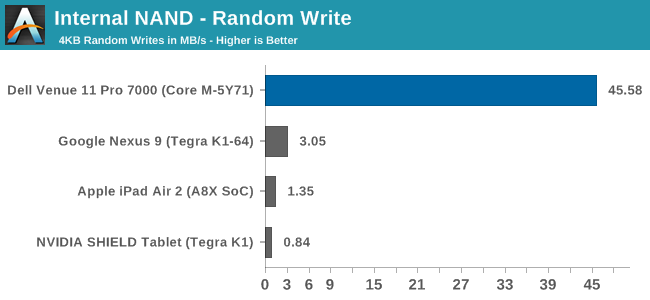
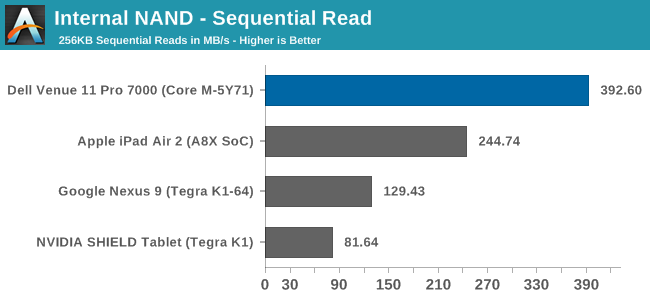
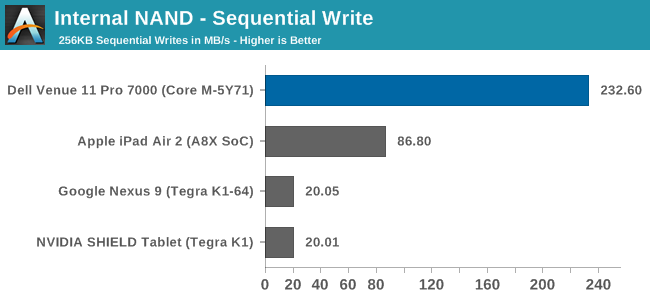
Building a tablet out of PC components still has its upsides, and storage performance is one of them. There is still quite a gap between a true SSD and eMMC storage. The Venue 11 Pro has the SanDisk X110 SSD, which is an older model drive, yet performance is still a good bit better than the average tablet.
Tablet Performance Summary
The Venue 11 Pro, with Windows 8.1, a Core M CPU, and a SSD, has very competetive performance compared to the standard tablets of today. There are certainly advantages to a true tablet, such as weight and thickness, but as far as performance, the Venue 11 Pro outclasses these devices in everything except GPU performance. The GPU performance is still good, but it is not class leading.










92 Comments
View All Comments
liahos1 - Thursday, April 16, 2015 - link
can you guys start adding normalized battery life for these products against tablets as well?ingwe - Thursday, April 16, 2015 - link
I would really appreciate having that back too. It isn't like I particularly care from a user perspective (obviously overall battery life is more important), but I really like to see how different platforms stack up in this regard.jjj - Thursday, April 16, 2015 - link
No idea why i even clicked , Core M is a horrible product for the price so got no interest at all in anything with it - hopefully AMD. Nvidia ,Qualcomm and ARM will catch up in single threaded perf at a fraction of the price soon. Well,maybe not ARM since A72 seems to be actually smaller than A57 , die size wise.Anyway this actually made me laugh when i realized that it kinda looks like the Moto Xoom except with thicker bezels (first Android tab ,4 years ago). OEMs should put more effort than this even in 100$ tabs.
Speedfriend - Thursday, April 16, 2015 - link
Apple managed a giant 10% improvement in single core performance between A7 and A8...So with the top Core M single core performance around 60% higher than the A8X, Apple will need to produce a miracle.
And as for the cost, a 128gb iPad Air 2 is $699+$100 for a decent keyboard case versus the low end core M equipped Asus T300 Chi which comes with a keyboard for $699. And the high end T300Chi, which will obliterate the iPAd Air 2 comes in at $899 with 8GB of memory
jjj - Thursday, April 16, 2015 - link
Apple has no relevance, they have many limitations and high prices so no reason to even consider them.MrSpadge - Thursday, April 16, 2015 - link
Apple has a lot of relevance here, because they've got the ARM core with the highest single threaded performance. If anyone closes the gap to Intel it's going to be them. Even if Qualcom could do it, they need to put 4 cores into phones for the "bigger is better" crowd, which means any single core must not be too big - otherwise people will complain that it gets too hot.And if Apple only got 10% on their last refresh they may be approaching the region of diminishing returns that Intel and AMD have long been in. It's easy to improve & grow when you start from nothing, but an entirely different matter once you look at mature technology.
jjj - Thursday, April 16, 2015 - link
Apple is not a reasonable purchase so it doesn't matter, even if they have 2 times the perf it's not relevant in the real world.It is true that the Android guys do need more cores in general but it's also true that Intel doesn't design it's cores for this kind of TDP. And do remember to compare sustained perf and burst perf.
I don't know for sure the core size for Broadwell on Intel's 14nm or A57 on 14nm Samsung but likely 7mm2+ vs bellow 2mm2 so A57 must be some 4 times smaller. For Apple 2 cores plus cache are some 12.5mm2 on 20nm TSMC but the cache is not very die efficient and on 14nm Samsung the 12.5mm2 would be closer to 10.5mm.
For A72 ARM claimed 2.4GHz sustained clocks on 16nmFF+ in phones and it appears they mean quad cores. It also appears that A72 is smaller than A57. The numbers i've seen were core size 3.3mm2 , quad cluster(so with cache) 18.7mm2 but not certain about process, i believe it's on 28nm but that could be wrong. A72 at 2.4GHz should be pretty good and it remains to be seen what's the burst perf and how it clocks at higher TDP. It's not impossible for it to be close enough in tabs. We should see the dual A72 @ 2.4GHz on 28nm from Mediatek soon in tabs (some early benchmarks are in the wild already) and later this year the Qualcomm midrange phone SoCs with A72 at 1.9GHz and that will give us a better idea about what kind of clocks would be needed on 16FF+ and 14nm.
Qualcomm's custom core must beat A72 or there is no point in using it and that's the case with all the other custom cores from AMD, Nvidia, Samsung and whatever else comes.
pSupaNova - Tuesday, April 21, 2015 - link
No Nvidia has the ARM core with the highest single threaded performance.Look at the Benchmarks in this site for the N9 tablet.
sonicmerlin - Thursday, April 16, 2015 - link
They had a 30-40% performance improvement in CPU.Speedfriend - Friday, April 17, 2015 - link
A8 at 1.4ghz single core geekbench 1619A7 at 1.4ghz single core geekbench 1468
Improvement = 10%